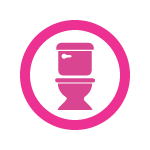What are the symptoms of bacterial cystitis?
The main symptoms include:17,21
 Pain or burning when urinating
Pain or burning when urinating
 Frequent need to pass small amounts of urine
Frequent need to pass small amounts of urine
 Feeling of urgency to pass urine even when the bladder is empty
Feeling of urgency to pass urine even when the bladder is empty
 Cloudy/dark urine, which may have a strong aroma
Cloudy/dark urine, which may have a strong aroma
What are the treatment options for bacterial cystitis?
Bacterial cystitis is usually treated with antibiotics, but if symptoms are mild it’s usually advisable to wait for the results of a urine test before prescribing them.17,22,36
Drinking plenty of water can help with the management of BC.35,37 It can also be a good idea for patients to urinate immediately after intercourse and not use a diaphragm.21,27,35 A heating pad/hot water bottle and pain relief medication can also help with symptoms.37 Some studies have indicated that drinking cranberry juice can reduce the chances of getting cystitis.37–39
If symptoms are bad or worsening, antibiotics can be started without delay and a three-day course is a usual treatment for each flare.19,22,36
However, flares may still occur when antibiotics are taken, but they should happen less often. If a flare does occur, it’s usually caused by bacteria which is resistant to the prescribed antibiotic. A urine sample is needed to check which bacterium is causing the flare, and a temporary change of antibiotic may be required.19,22
In some cases, bacterial cystitis may recur as a consequence of abnormal breakdown and production of mannose, which enables bacteria to adhere to the walls of the urinary tract more easily. In these cases, supplements can help counteract this deficiency, and can also significantly reduce the risk of recurrent UTIs.40
References
- 17.Medline Plus. Cystitis - acute. medlineplus.gov/ency/article/000526.htm. Published 2016. Accessed September 1, 2017.
- 19.Barber AE, Norton JP, Spivak AM, Mulvey MA. Urinary Tract Infections: Current and Emerging Management Strategies. Clin Infect Dis. 2013;57:719-724. doi:10.1093/cid/cit284.
- 21.Bladder Health UK. Bacterial Cystitis. www.bladderhealthuk.org/bladder-conditions/cystitis/bacterial-cystitis. Published 2017. Accessed September 1, 2017.
- 22.Kenny T, Harding M, Knott L. Recurrent cystitis in women. Patient. patient.info/health/recurrent-cystitis-in-women Discuss. Published 2016. Accessed September 1, 2017.
- 27.Grabe M, Bartoletti R, Bjerklund-Johansen T, et al. Guidelines on Urological Infections.; 2015. doi:10.3201/eid0702.010240.
- 35.Taylor D. Recurrent Cystitis in Women. 2003.
- 36.Naber K. Treatment options for acute uncomplicated cystitis in adults. J Antimicrob Chemother. 2000;46(Suppl. 1):23-27. doi:10.1093/jac/46.suppl_1.23.
- 37.NHS Choices. Cystitis - Treatment. www.nhs.uk/Conditions/Cystitis/Pages/Treatment.aspx. Published 2015. Accessed July 20, 2009.
- 38.WebMD. Does cranberry juice help with urinary tract infections. www.webmd.boots.com/women/guide/utis-cranberry-juice. Published 2016. Accessed September 1, 2017.
- 39.Jepson R, Williams G, Graig J. Cranberries for preventing urinary tract infections. Cochrane Database Syst Rev. 2012.
- 40.Kranjčec B, Papeš D, Altarac S. D-mannose powder for prophylaxis of recurrent urinary tract infections in women: a randomized clinical trial. World J Urol. 2014;32(1):79-84. doi:10.1007/s00345-013-1091-6.

